Abstract
The modern logistics industry is grappling with significant challenges brought about by rapid market transformations. These challenges encompass workforce shortages, the increasing complexity of diverse logistics systems, environmental concerns arising from unregulated warehouse construction, and the scarcity of available land for development. In response to these pressing issues, this study introduced an automated logistics warehouse system that incorporated stackable bidirectional infinite-loop modules and employed a pre-transfer method. Extensive simulations rigorously validated the feasibility and effectiveness of this system, affirming its substantial capacity to enhance spatial utilization and operational efficiency within warehouses. Consequently, this study not only offers solutions to streamline transfer device routes, optimize storage space, reduce workforce demands, and contribute to economic gains, but also addresses labor shortages and land scarcity challenges. The overarching objective of this study was to provide pragmatic strategies for effectively tackling the multifaceted challenges confronting the logistics industry.
1. Introduction
The online market is currently experiencing a significant surge, driven by advancements in information technology, and is actively shaping new global consumption trends, particularly in response to the impact of COVID-19. This evolving trend has led to a noticeable increase in the volume of small orders for various products, highlighting the growing importance of same-day delivery services [1]. Notably, same-day delivery services for fresh food, considered essential, have gained considerable attention in Korea, with their scale consistently expanding alongside the spread of COVID-19. Consequently, efficient logistics systems have become crucial, making the expansion and innovation of automated logistics warehouses indispensable [2]. In particular, there is a growing interest in logistics warehouses responsible for the selection and retrieval of ordered goods from inventories [3]. While the importance of warehouse management has been emphasized in the past, traditional warehouses were primarily perceived as places for storing goods. However, recent years have seen a rapid increase in logistics volume in Korea, particularly under the influence of services like same-day delivery. The ability to quickly locate and process goods within warehouses has thus become paramount. Moreover, owing to the escalating land prices in metropolitan areas of Korea, driven by dense population centers, the demand for warehouses that maximize space utilization and operational efficiency has surged [4,5]. These logistics warehouses, primarily concentrated in the Seoul Capital Area, are undergoing modernization and evolving into logistics warehouses that incorporate artificial intelligence to create new added value [6]. Major e-commerce and logistics companies, such as Coupang, CJ Logistics, and Lotte Mart in Korea, Amazon in the United States of America, Ocado in the United Kingdom, DHL in Germany, and JD.COM in China, are expanding their investments in automated warehouses as a crucial strategy to enhance their competitiveness [7]. However, existing automated logistics warehouses face limitations in achieving both spatial efficiency and increased speed of logistics operations. These limitations stem from constraints based on horizontal expansion, complexity of stacked systems, and high land prices in densely populated areas [8]. Logistics warehouses prioritize quick delivery and accessibility, leading to the concentration of most warehouses in metropolitan and other densely populated regions. Given the characteristics of these areas, land prices are exorbitant, which increases warehouse construction costs and makes it increasingly challenging to secure new spaces nearby. Consequently, the issue of space utilization in existing warehouses becomes a pivotal consideration, accompanied by several constraints. First, the expansion of logistics warehouses in confined spaces primarily relies on horizontal expansion [9]. However, securing additional land in surrounding areas in densely populated regions is a formidable challenge. Additionally, the expansion of stacked systems presents its own set of challenges. Constructing high-rise buildings must account for various variables, including structural stability, fire and safety regulations, and logistics operational efficiency. Therefore, simply adding floors to warehouses is a limited solution. These challenges are critical factors influencing the efficient operation of logistics warehouses [8].
The present study introduces a novel warehouse design aimed at overcoming the shortcomings of horizontal and stacked expansion approaches. This innovative design not only boosts spatial efficiency and logistics operation speed but also offers a strategic solution to alleviate space acquisition and cost-related challenges in warehouse location decisions within densely populated areas. Our warehouse design centers around a stackable bidirectional infinite-loop module to facilitate both horizontal and vertical expansion. This module is engineered to optimize spatial utilization and enhance logistics operation speed, providing an effective remedy for the challenges associated with warehouse location decisions in densely populated regions. Additionally, while there are various examples of automated warehouse layouts, this is the first study to introduce stackable bidirectional infinite-loop modules.
The remainder of this paper is organized as follows: Section 2 reviews existing research on automated logistics warehouses, Section 3 elucidates the concept and operating method of the proposed stackable bidirectional infinite-loop module, Section 4 outlines the experimental methods and simulations, and Section 5 concludes with a discussion of this study’s significance and avenues for future research.
2. Literature Review
Automated storage and retrieval systems (AS/RSs) have emerged as pivotal technologies in the logistics industry, serving essential functions such as storage, order picking, distribution, assembly, and kitting across diverse sectors [10]. The importance of AS/RSs has been highlighted in various industries since the late 1990s, including smart farming, e-commerce, aviation, food, semiconductors, and healthcare. Existing research on AS/RSs includes storage space allocation, driving time allocation, operation control systems and equipment construction, task sequence determination [11], supply chain management efficiency, revenue maximization strategies through cost reduction, optimal pricing, and service quality improvement [12,13].
The application of AS/RSs in vertical farms is particularly noteworthy, addressing challenges related to land and labor shortages, with the potential for yield improvements of up to 6000 times per hectare for certain crops compared to traditional methods [14]. Vertical farms hold promise for revolutionizing future food production [15]. Figure 1 depicts various forms of vertical farms utilizing automated logistics warehouse systems.

Figure 1.
(a) Vegetable factory production line of Fujitsu AkiSai (source: home page of Fujitsu Japan, https://kieae.kr/_common/do.php?a=full&b=12&bidx=980&aidx=12994 (accessed on 29 September 2023)); (b) Swiss Rogue/s vertical farming automation system (source: Swiss log, 2021, https://www.swisslog.com/en-us/case-studies-and-resources/blog/vertical-farming (accessed on 29 September 2023)); (c) vertical farm (source: home page of AeroFarms USA, https://www.aerofarms.com/about-us/ (accessed on 29 September 2023)).
A significant body of research has been dedicated to optimizing warehouse operations. Notable methodologies include the alternative layout method, introduced by Muther in 1973, emphasizing systematic inventory layout planning through activity relationship matrices [16]. Gu et al. [17] categorized warehouse layout methods into warehouse design and operations, stressing the importance of considering the hardware and software elements for efficient inventory management. Jo et al. [18] proposed division strategies for picking and replenishment areas to enhance unit loading rates, while Song et al. [19] focused on optimizing the location layout of high-outbound proportion items. Several heuristic algorithms have been employed to configure layouts effectively, minimizing operating costs in the storage location assignment problem [20,21,22,23,24]. Efforts have also been concentrated on improving warehouse operational efficiency. Kim et al. [10] explored the efficiency gains from introducing automated guided vehicles (AGVs) in convenience store logistics centers. Dubey et al. [25] investigated logistics center size-related challenges. Hwang et al. [26] designed an optimal operating system for order picking in loading and unloading yards, considering the characteristics of refrigerated cargo. A simulation was conducted based on a standardized repair model that determined the operating time of the transportation equipment by setting the design parameters. A study was conducted to analyze the performance of alternatives related to operations depending on the amount of transportation equipment. Jarvis et al. [27] employed allocation algorithms to minimize travel and order picking time by strategically placing high-order frequency items near exits. Finally, Le-Duc et al. [28] proposed a model for determining the optimal number of zones in a picking system using mixed integer programming.
When experiments are difficult or impossible to perform, simulations using models are used to conduct various virtual experiments. Simulations are applied in diverse fields such as in industry, education, gaming, design, testing, economics, environment, and daily life [29]. The process of creating the model for simulations is called modeling. Physical simulation models use actual models that are created for experimentation in a virtual environment to study the properties of objects and are used in areas such as architecture, animation, design, temperature, structure, and motion. Logical simulation models, also known as mathematical or analytical models, are used for interpreting mathematical logic structures. Logical simulation models involve setting decision variables and applying heuristic interpretation, considering limited information and time constraints, and are used in statistical models, among others [30]. When simulation modeling is performed using computers, it is referred to as a computer simulation. Utilizing computational power allows model changes to be observed through iterative operations. Static simulations disregard the passage of time, whereas dynamic simulations consider the passage of time. Computer simulation modeling is increasingly being applied for the prediction and validation of processes, such as the feasibility of new designs, optimization of operations, and planning in automated logistics warehouse systems [31].
Simulation-based research has also proliferated, with studies comparing and analyzing operational and overall efficiencies of logistics centers using genetic algorithms and simulations [9,32,33]. Hausman et al. [34] modeled the average operating time for scheduling stacker cranes using pallet loading and storage location allowances. Graves et al. [35] simulated the average operating time when performing commands using continuous and discrete storage methods in racks in high-rise storage warehouses. Bozer et al. [36] studied the average operating time for single- and double-command operations in non-SIT (selective pallet racking) racks by considering the input and output locations when the S/R machine (storage/retrieval machine) moved vertically and horizontally. Furthermore, research on automated logistics warehouse systems for vertical farms has gained momentum. Chen et al. [37] presented a simulation model that improved operating efficiency by 20% compared to existing vertical farms. Lee et al. [38] implemented an automated logistics warehouse system that enhanced operational efficiency and food quality through robotics and environmental control systems. Cho et al. [39] designed a layout tailored to vertical farm characteristics, demonstrating high efficiency through simulation evaluations. Li et al. [40] explored space efficiency improvements using AGVs. Cho et al. [41] proposed a mixed-integer programming model for layout design, validated through simulation. Wang et al. [42] introduced an optimal solution using genetic algorithms for logistics warehouse layout on vertical farms. Zhang et al. [43] assessed the efficiency of an optimal layout design through simulations using a hybrid approach.
Despite the extensive research in this area, criticisms have arisen regarding the focus on equipment performance improvement within AS/RS research. For example, Roodbergen et al. [44] underscored the necessity of more attention to layout design problems in AS/RS. De Koster et al. [45] emphasized the critical role of order picking as the most cost-intensive aspect in automated logistics warehouses, underscoring the need for efficient performance to avoid unsatisfactory service and high operating costs. Vasili et al. [46] highlighted the importance of adopting diverse perspectives beyond time-estimation models and performance enhancement.
To address these limitations, this study proposes a comprehensive layout design suitable for storing and picking a variety of products, taking into account the unique characteristics of vertical farms and verifies its validity through a simulation involving the implementation of an actual operating system as a logical model, which optimizes the efficiency of the automated logistics system in practice.
3. Materials and Methods
3.1. Stackable Bidirectional Infinite-Loop Module Concept
The typical configuration of an existing logistics warehouse is depicted in Figure 2a, where racks are arranged with aisles designed between them for inventory transportation. A variety of transportation devices, including forklifts, stacker cranes, and lifts, operate within these aisles. The selection of these devices depends on factors such as warehouse type, size, degree of automation, and inventory characteristics.
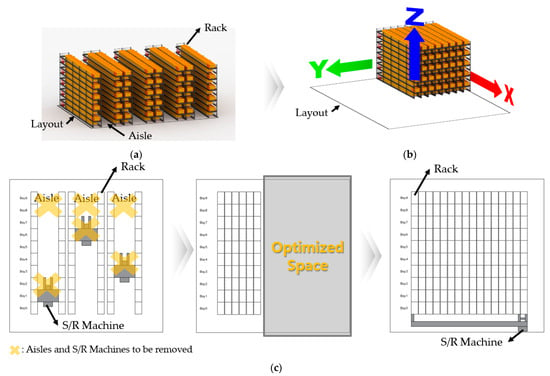
Figure 2.
(a) General form of logistics warehouse; (b) structure of a logistics automated warehouse with stackable bidirectional continuous track modules; (c) advantages in space and area due to secured space.
This study aims to improve upon various warehouse storage methods, particularly the configuration depicted in Figure 2a. In Figure 2b, we propose the removal of aisles and the addition of racks to accommodate more inventory items to maximize spatial utilization. Figure 2c illustrates the benefits of implementing the improvements suggested in Figure 2b through a floor plan.
This innovative method has the potential for efficient application not only in automated logistics warehouses but also in smart farms, particularly vertical farms, which demand optimized space usage within confined spaces (Figure 1) [47]. Vertical farming, which is gaining attention as a future urban agricultural model, entails growing crops vertically in urban settings, offering advantages such as minimized water and land usage, pest control in controlled environments, consistent year-round production, and resource-efficient crop growth [14]. Additionally, utilizing the proposed stackable bidirectional infinite-loop module approach will serve as an effective solution to current issues such as land scarcity and labor shortages owing to an aging workforce [48].
3.2. Operation of Stackable Bidirectional Infinite-Loop Module
The stackable bidirectional infinite-loop module, as shown in Figure 3a, consists of two stacked layers or stacks. Instead of traditional steel racks for inventory storage, this design employs conveyors or similar continuous transport mechanisms. In this study, conveyors served as the fundamental component. The conveyor checks the inventory location and transports it to the lift in the direction closest to the lift, based on the horizontal direction. The lift transports the inventory in the vertical direction up and down and serves as a waiting area for the logistics to be transported to the buffer. Inventory waiting for shipment are stored in the buffer. The inventory that arrives at the buffer is transferred to the worker by the stacker crane in order of arrival. The stacker crane, located on both sides of the rack where the buffer is located (Figure 3b), transfers the inventory that has arrived at the buffer to a worker responsible for receiving incoming and outgoing inventory. An example of the circulation of logistics using the stackable bidirectional infinite-loop module illustrated in Figure 3 can be found in Appendix A.
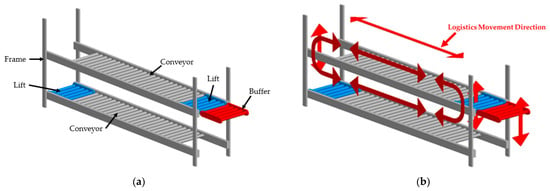
Figure 3.
(a) Concept diagram of bidirectional continuous track modules; (b) logistics movement direction of bidirectional continuous track modules where the red arrows represent the direction of logistics movement.
In a logistics replenishment process, the vacant spaces created by outgoing shipments are refilled with other inventory items through a function known as reload. Reload refers to the process of filling the empty spaces left by dispatched logistics with different inventory items. In conventional warehouses, this task is typically performed by handling equipment such as forklifts, lifts, and stacker cranes. Reload enhances spatial efficiency [49]. However, in this study, by employing a bidirectional infinite-loop module using a stacking method, conveyors perform the roles of lifts, stacker cranes, and racks.
Once the inventory logistics are dispatched via handling devices and buffers, a repetitive process ensues where the next set of inventory logistics to be dispatched is located and positioned within the buffer. This operation, named the pre-transfer system (or free-transfer system), takes place independent of the stacker crane’s activities, occurring whenever both the buffer and lift positions are unoccupied. Figure 3a illustrates the concept of the bidirectional infinite-loop module, while Figure 3b indicates the movement directions of the logistics (arrows represent buffer directions) and the conveying devices, including conveyors and lifts.
3.3. Pre-Transfer System
Pre-transfer refers to the process where logistics pre-scheduled for next shipment are moved via conveyor to an empty buffer or lift while awaiting the stacker crane. Logistics items to be transferred are directed through the conveyor in the closest horizontal or vertical direction. If both the buffer and lift within the module are empty, the pre-transfer occurs irrespective of the stacker crane’s schedule. This system significantly reduces waiting and transfer times, enhancing the efficiency of logistics shipment. Each module operates with its pre-transfer system, ensuring that logistics items queue up in the buffer and lift according to the specified order in the shipping instructions. Figure 4a provides a visual representation of the logistics movement, illustrating both horizontal and vertical progress indicated by the arrows. The pre-transfer system utilizes bidirectional conveyors to advance logistics items, as highlighted by the arrows in Figure 4a.
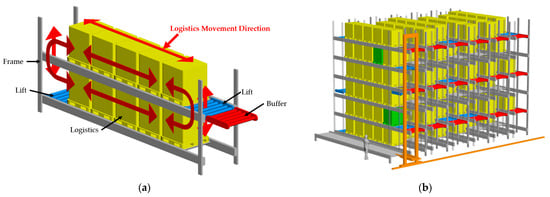
Figure 4.
(a) Concept diagram of the pre-transfer system applied in the research; (b) concept diagram of the constructed rack structure.
4. Experimental Design
To perform a simulation of an automated warehouse system utilizing stackable bidirectional infinite-loop modules, several assumptions were made, as outlined in Table 1, Table 2 and Table 3. These assumptions were based on the rationale that larger models tend to consume excessive resources in simulation experiments because larger models take longer to run and require more computing resources owing to their complexity. Additionally, the accuracy of simulation models is generally affected by their size, and larger models can lead to decreased accuracy [50]. Therefore, this experiment used a virtual model of a small warehouse, as shown in Table 1.

Table 1.
Input parameters based on rack configuration and operation strategy.

Table 2.
Assumed transport speed by equipment (unit: m/min).

Table 3.
Input parameters based on operation strategy.
The basic input parameters for the experiment were set as shown in Table 1 and Table 2, depending on the rack configuration and operational plan. Even if the amount of logistics to be stored was the same, the storage height varied depending on the type of transportation equipment used. The height of the racks for the forklift and stacker crane were set to 7.5 and 21.75 m, which are the heights at which inventory can be lifted by a forklift and stacker crane, respectively, based on the specifications provided by the Korea Occupational Safety and Health Agency.
To store the same amount of logistics, the number of rows and columns of the rack was set according to the type of transportation equipment used to match the height of the rack. The number of logistics calls was set at a maximum of 1800 PLT (pallet). The logistics storage method within the rack was assumed to be random storage (free location). The specific attributes of stored logistics were defined with a height, width, and length as 1.1, 1.1, and 1–1.6 m, respectively. Each storage unit was assumed to contain a single item. Figure 5a,b show a plan view of the rack, where the terms used for each unit are indicated.
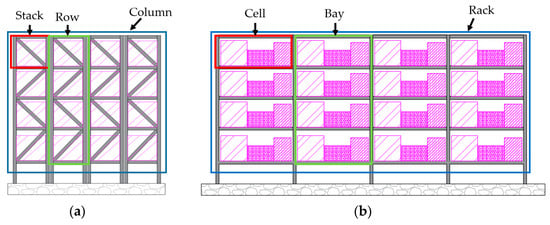
Figure 5.
(a) Right side view of the rack; (b) front view of the rack.
Equipment speeds can vary based on the manufacturer and product model. Table 2 outlines the equipment speeds used in this study, following the work safety standards of the Korea Occupational Safety and Health Administration. The minimum, maximum, and most frequent values for both horizontal and vertical movement speeds of each piece of equipment were determined using the probability density function of the triangular distribution.
For the experiments, we restricted the total logistics volume to a maximum of 1800 PLT. Two experiments were conducted based on the distribution of logistics: one with an equal ratio of input to output, and another introducing a virtual bottleneck scenario. In the bottleneck scenario, considering the total logistics volume of 1800 PLT, the input ratio was set to 70 and 30% of the total volume for experiments with high and low input rates, respectively. Various bottleneck scenarios, such as concentrated input, output, or both, can occur. To address this, the input and output ratios were adjusted to simulate different bottleneck situations. The input and output cycles followed a single-mode approach, where tasks, including input, storage, and output, were processed sequentially. Command processing adhered to a single-command method, allowing only one task to be executed at a time. Logistic retrieval was done randomly using the first-in-first-out (FIFO) method, assuming a 100% pickup rate (Table 3).
4.1. Simulation
4.1.1. Current and Target Settings
Two settings were established for the rack layout and transportation equipment (S/R machine) in the logistics storage warehouse: current (as-is) and target (to-be).
- As-is fork liftGeneral logistics storage warehouse where logistics are transported using forklifts. There is a gap between the racks through which forklifts can travel;
- As-is stacker craneAutomated logistics warehouses use stacker cranes for logistics transportation. The racks were arranged so that the stacker cranes could travel through them;
- To-be stacker craneThe proposed automated logistics warehouse, in which logistics are transported to workers through a conveyer and stacker crane, eliminates the gap between the racks.
4.1.2. Experimental Design
An experiment was conducted to deliver a specified number of logistics units with the same ratio of input and output to workers. The maximum number of logistics workers that can be called was 1800 PLT.
- First experimentThe experiment was repeated 250 times, assuming that the number of logistics to be called was 100 PLT, and that one PLT was released in a first-in, first-out order;
- Subsequent experimentsThe experiment was conducted 250 times for 300, 600, 1000, and 1800 PLT logistics called. Logistics involve products that have a variety of small quantities and frequent outputs. The products to be called were tested such that they were released in order by random call or first-in, first-out.
4.2. Process Design and Implementation
To measure the duration of the logistics output, we constructed a model using Python Version 3.9, a programming language widely utilized for tasks such as data processing, analysis, machine learning, and deep learning. The structure related to logistics intake and output employed a queue module with a FIFO structure. This method is commonly used in automated logistics management [42] and is advantageous for inventory management as it prioritizes the outgoing of previously received logistics items when handling the same logistics multiple times [45]. Additionally, literal values representing fixed constants were declared and utilized as integers in the model. Visual validation was performed using Unreal Engine 5 [50], a renowned open-world real-time 3D creation multi-platform, to simulate the to-be stacker crane, as illustrated in Figure 6.
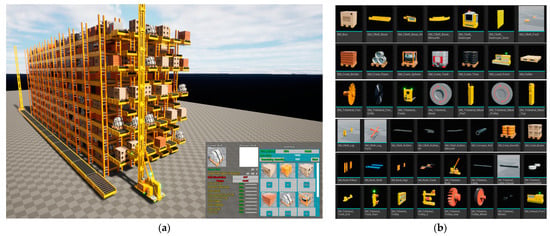
Figure 6.
(a) Visual representation of the to-be stacker crane constructed using Unreal Engine 5; (b) static meshes used in Unreal Engine 5.
5. Results
5.1. Experimental Results of Balanced Inventory Logistics
The experimental results of 250 simulation runs regarding the time required for the selection, retrieval, and delivery of ordered goods from the warehouse to the worker, until the task was completed, are summarized in Table 4.

Table 4.
Average time taken for calls of a specified amount of logistics.
The to-be stacker crane model took 2.03 h to process 100 PLT, 6.09 h for 300 PLT, 12.15 h for 600 PLT, 20.28 h for 1000 PLT, and 36.53 h for 1800 PLT. These results indicate that the to-be stacker crane model can efficiently utilize time, with improvements ranging from approximately 37.54 to 73.22% when compared to the as-is fork lift and as-is stacker crane models. Thus, we demonstrated that time optimization is achievable using our proposed warehouse design.
Figure 7 visually depicts the time differences among the models based on call quantity, further validating the developed model’s time efficiency.
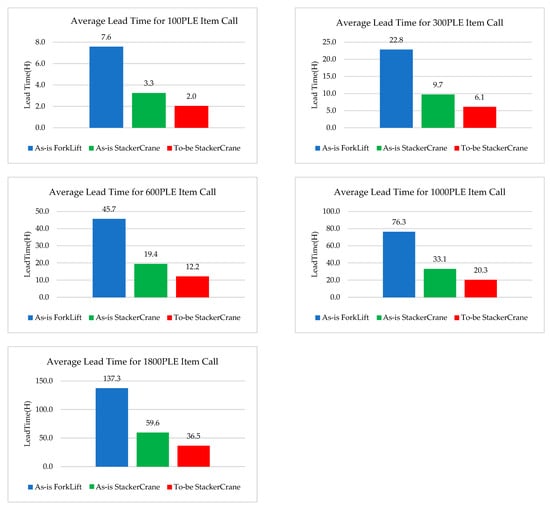
Figure 7.
Comparison of average response time for calls at equal ratios of specified logistics quantities between models.
5.2. Experimental Results Using Virtual Bottleneck Phenomenon in Inventory Logistics
The results of experiments conducted with a virtual bottleneck phenomenon are presented in Table 5. For experiments where a high input rate occurred, 70% of the total logistics volume was allocated for input, while for experiments with a low input rate, 30% of the total logistics volume was allocated for input, based on a maximum total volume of 1800 PLT. According to the experimental findings, there was an approximate 73.31% difference in time-based probability between the to-be stacker crane and as-is fork lift models. Additionally, a time-based probability difference of around 38.39% was observed between the to-be stacker crane and as-is stacker crane models.

Table 5.
Experimental results on logistics call lead time using bottleneck phenomena.
Figure 8 visually represents the results of the experiments on the call durations of logistics using a simulated bottleneck phenomenon. In Figure 8a, the results are represented based on the total logistics volume of 100, 300, 600, 1000, and 1800 PLT, with each scenario allocating 30% of the total logistics volume for input. It is evident that the to-be stacker crane model consumed less time compared to the as-is stacker crane and as-is fork lift models. Figure 8b illustrates the results when 70% of the total logistics volume, based on 100, 300, 600, 1000, and 1800 PLT, is allocated for input. Again, the to-be stacker crane model exhibits lower time consumption compared to the as-is stacker crane and as-is fork lift models. Through these observations, it is confirmed that the developed model approach is highly time efficient.
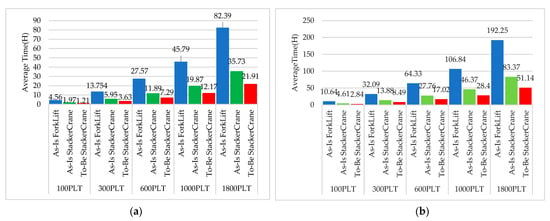
Figure 8.
(a) Comparison graph of logistics call lead time using bottleneck phenomena: experimental results (outbound 7); (b) comparison graph of logistics call lead time using bottleneck phenomena: experimental results (outbound 3).
6. Conclusions
In this study, we proposed an automated logistics warehouse model incorporating stackable bidirectional infinite-loop modules to address the changing demands and challenges of the logistics market. Through simulations, we observed a time efficiency improvement ranging from approximately 37.54 to 73.22% depending on the quantity of logistics processed, when compared to models without the stackable bidirectional infinite-loop modules. Even in simulated bottleneck scenarios, typical of logistics automation warehouses, the proposed model exhibited time efficiencies of approximately 38.39 to 73.31% depending on the quantity of logistics processed. These results clearly demonstrate the superior processing capabilities of the model with stackable bidirectional infinite-loop modules compared to conventional logistics automation warehouses.
The introduction of this automated logistics warehouse model with stackable bidirectional infinite-loop modules is expected to offer solutions to the challenges faced by current automated warehouses. This includes maximizing storage capacity through enhanced space utilization, faster processing speeds owing to swift incoming and outgoing logistics, resolving workforce shortages, and improving land usage efficiency. Moreover, the application of these stackable bidirectional infinite-loop modules in vertical farms within the context of smart farming holds promising potential. Additionally, it is expected to contribute toward a reduced workload owing to the reduction in labor requirements as a result of the enhanced efficiency in logistics movement.
For future research, it is crucial to focus on the hardware design of the system incorporating stackable bidirectional infinite-loop modules and ensure its validation in various fields such as logistics and vertical farming. Through validation, potential avenues for increasing energy efficiency, strengthening sustainability, and enhancing overall environmental friendliness of the entire system should also be explored.
Author Contributions
Conceptualization, K.M. and D.L.; software, K.M.; validation, D.L.; resources, K.M. and D.L.; writing—original draft preparation, K.M.; writing—review and editing, K.M. and D.L.; supervision, D.L. All authors have read and agreed to the published version of the manuscript.
Funding
This work was supported by the Korea Institute of Energy Technology Evaluation and Planning (KETEP) grant funded by the Republic of Korea government (MOTIE) (No. 20224000000080).
Institutional Review Board Statement
Not applicable.
Informed Consent Statement
Not applicable.
Data Availability Statement
The data presented in this study are available on request from the corresponding author. The data are not publicly available due to ongoing research collaborations and publication commitments.
Conflicts of Interest
The authors declare no conflict of interest.
Appendix A
Examples related to logistics movement utilizing the concept diagram of bidirectional continuous track modules (➀➁➂ indicates the order of shipments and the red arrows represent the direction of logistics movement). The logistics called in the manner described are transported accordingly. Please note that while the flow of logistics was illustrated in one direction in the images, logistics can also move in the opposite direction depending on their location. This is a method implemented to reduce response time during calls.
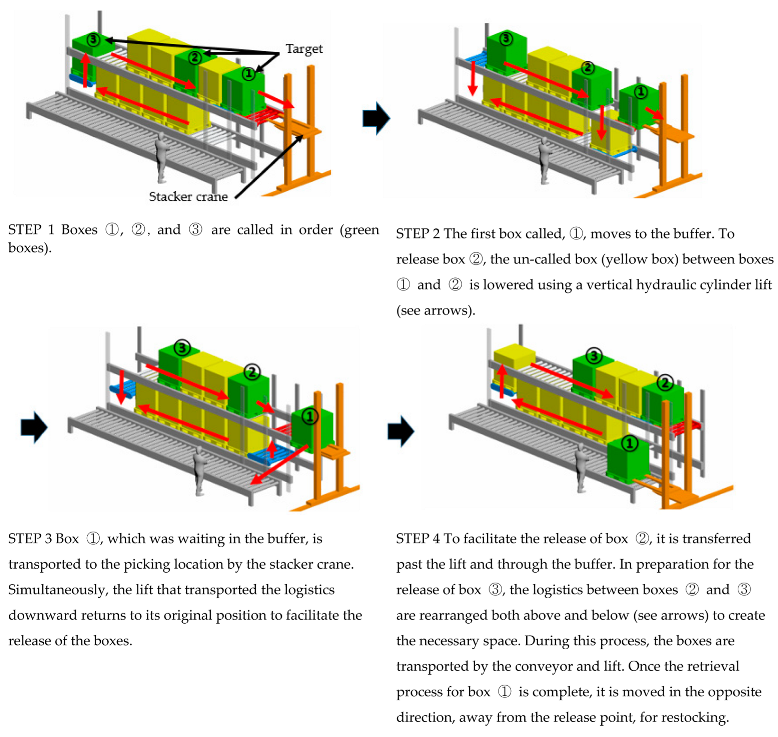

References
- Statistics Korea. Economic Statistics Bureau; Service Industry Trends Division. In Online Shopping Trends; Statistics Korea: Daejeon, Republic of Korea, 2019. [Google Scholar]
- Berg, J.P.V.; Zijm, W.H.M. Models for warehouse management: Classification and examples. Int. J. Prod. Econ. 1999, 59, 519–528. [Google Scholar] [CrossRef]
- Jo, Y.H.; Choi, C. A study on the architectural changes of the logistics center due to automation and enlargement—Focusing on the case of Coupang, E-Mart, Amazon Logistics Centers. J. Archit. Inst. Korea Plan. Des. 2020, 36, 37–48. [Google Scholar]
- Chun, S.J.; Lee, Y.H. Travel time models for automated storage/retrieval systems with racks of different size. J. Korean Inst. Ind. Eng. 1997, 23, 421–432. [Google Scholar]
- Kim, O.T.; Yu, D.S.; Yu, Y.S.; Park, J.H. Trends in conveyance and storage equipment technology in smart logistics centers. Mag. IEIE 2012, 39, 59–68. [Google Scholar]
- Scherer, R.J.; Schapke, S.-E. A distributed multi-model-based management information system for simulation and decision-making on construction projects. Adv. Eng. Inform. 2011, 25, 582–599. [Google Scholar] [CrossRef]
- Hana Securities Co., Ltd. Should You Invest in Logistics Robots Now? 2023. Available online: https://www.hanaw.com/download/research/FileServer/WEB/industry/industry/2023/05/12/230512_AMR_industry.pdf (accessed on 15 August 2023).
- Jang, Y.S.; Lee, B.L.; Lee, H.C. A simulation study on performance improvement of the military AS/RS based travel time of S/R machine. J. Mil. Oper. Res. Soc. Korea 2009, 35, 63–76. [Google Scholar]
- Hwang, E.S.; Baek, S.W. A study on the optimal design of an automated military logistics center using simulation and hierarchical analysis method. J. Korea Acad. Ind. Coop. Soc. 2014, 15, 725–734. [Google Scholar]
- Kim, J.; Kim, Y.; Lee, H. Simulation analysis of AGV in convenience store distribution logistics centers. J. Korea Acad. Ind. Coop. Soc. 2016, 17, 61–69. [Google Scholar]
- Lee, J. Trends in the automated logistics equipment market and domestic perception survey. In Logistics Trends of East Asia; Busan Development Institute: Busan, Republic of Korea, 2015; pp. 92–101. [Google Scholar]
- Barman, A.; Das, R.; De, P.K. Optimal pricing, replenishment scheduling, and preservation technology investment policy for multi-item deteriorating inventory model under shortages. Int. J. Model. Simul. Sci. Comput. 2021, 12, 2150039. [Google Scholar] [CrossRef]
- Barman, A.; Chakraborty, A.K.; Goswami, A.; Banerjee, P.; De, P.K. Pricing and inventory decision in a two-layer supply chain under the weibull distribution product deterioration: An application of NSGA-II. RAIRO-Oper. Res. 2023, 57, 2279–2300. [Google Scholar] [CrossRef]
- Lee, D.; Chang-wook, L.; Sun-geun, K. A study of platent network comparative analysis Base on International Patent Classification Code: Focusing on ‘smart farm’ in Korea, the United States, and Japan. Asia-Pac. J. Multimed. Serv. Converg. Art Humanit. Sociol. 2018, 8, 43–51. [Google Scholar]
- Asseng, S.; Guarin, J.R.; Raman, M.; Monje, O.; Kiss, G.; Despommier, D.D.; Meggers, F.M.; Gauthier, P.P.G. Wheat yield potential in controlled-environment vertical farms. Proc. Natl. Acad. Sci. USA 2020, 117, 19131–19135. [Google Scholar] [CrossRef] [PubMed]
- Muther, R. Systematic Layout Planning; Cahners Publishing: Boston, MA, USA, 1973; p. 12. [Google Scholar]
- Gu, J.; Goetschalckx, M.; McGinnis, L.F. Research on warehouse operation: A comprehensive review. Eur. J. Oper. Res. 2007, 177, 1–21. [Google Scholar] [CrossRef]
- Jo, G.-S.; Lee, D.-W.; Lee, Y.-J.; Kim, H.-G. A study on the operational efficiency improvement of refrigerated warehousing systems in the Busan area. In Proceedings of the Korean Institute of Industrial Engineers Fall Conference, Jeju, Republic of Korea, 12 June 2010; pp. 879–883. [Google Scholar]
- Song, I.-S.; Cho, N.-U. Prediction-based optimal storage location decision model for logistics management system. J. Korean SCM Soc. 2015, 15, 7–17. [Google Scholar]
- Montulet, P.; Langevin, A.; Riopel, D. Minimizing the peak load: An alternate objective for dedicated storage policies. Int. J. Prod. Res. 1998, 36, 1369–1385. [Google Scholar] [CrossRef]
- Lee, M.-K. A storage assignment policy in a man-on-board automated storage/retrieval system. Int. J. Prod. Res. 1992, 30, 2281–2292. [Google Scholar] [CrossRef]
- Brynzér, H.; Johansson, M.I. Storage location assignment: Using the product structure to reduce order picking times. Int. J. Prod. Econ. 1996, 46–47, 595–603. [Google Scholar] [CrossRef]
- van Oudheusden, D.L.; Zhu, W. Storage Layout of AS/RS Racks Based on Recurrent Orders. Eur. J. Oper. Res. 1992, 58, 48–56. [Google Scholar] [CrossRef]
- Liu, C.H.; Lu, L.Y. The procedure of determining the order picking strategies in distribution center. Int. J. Prod. Econ. 1999, 60–61, 301–307. [Google Scholar]
- Dubey, V.K.; Veeramani, D.A. Framework for sizing an automated distribution center in a retail supply chain. Simul. Model. Pract. Theory 2017, 75, 113–126. [Google Scholar] [CrossRef]
- Hwang, J.; Lee, I.; Kim, H.; JungChoi, K.; Bahk, J.; Jung, M. Analysis of task and postures of retail grocery store workers. IE Interfaces 2011, 24, 387–395. [Google Scholar] [CrossRef]
- Jarvis, J.M.; McDowell, E.D. Optimal product layout in an order picking warehouse. IIE Trans. 1991, 23, 93–102. [Google Scholar] [CrossRef]
- Le-Duc, T.; De Koster, M.B.M. Determining Number of Zones in a Pick-and-Pack Order Picking System; Erasmus Research Institute of Management: Rotterdam, The Netherlands, 2005. [Google Scholar]
- Hong, J.H.; Seo, K.; Kim, T.G. Simulation-based optimization for design parameter exploration in hybrid system: A defense system example. Simulation 2013, 89, 362–380. [Google Scholar] [CrossRef]
- Choi, S.K. A Study on the Implementation of Vertical Tray Conveyor System in Multi-Layered Logistics Centers Based on Simulation. Ph.D. Dissertation, Korea Maritime and Ocean University, Busan, Republic of Korea, 2014. [Google Scholar]
- Kempfer, L. Top 5 Reasons to Use Warehouse Simulation Softwar eMaterial Handling Management. Available online: https://www.mhlnews.com/technology-automation/article/22038532/top-5-reasons-to-use-warehouse-simulation-software (accessed on 11 February 2023).
- Park, T.; Nam, J.-H.; Kim, T.-S.; Ryu, K.-R. Multi-objective cooperative resonance algorithm for reorganization of equipment yard in automated container terminal. J. Korean Inst. Inf. Sci. Appl. 2012, 39, 45–55. [Google Scholar]
- Jung, S.I.; Kim, E.T. Study on real-time task assignment in a multiple AGV system. In Proceedings of the Control, Robotics, and Systems Symposium, Barcelona, Spain, 18–22 April 2005; pp. 551–556. [Google Scholar]
- Hausman, W.H.; Schwarz, L.B.; Graves, S.C. Optimal storage assignment in automatic warehousing systems. Manag. Sci. 1976, 22, 629–638. [Google Scholar] [CrossRef]
- Graves, S.C.; Hausman, W.H.; Schwarz, L.B. Storage-retrieval interleaving in automatic warehousing systems. Manag. Sci. 1977, 23, 935–945. [Google Scholar] [CrossRef]
- Bozer, Y.A.; White, J.A. Travel-time models for automated storage/retrieval systems. IIE Trans. 1984, 16, 329–338. [Google Scholar] [CrossRef]
- Chen, Z.; Guo, W.; Wang, Y.; Zhang, S. A Simulation model for an automated storage and retrieval system in a vertical farm. Comput. Electron. Agric. 2021, 172, 105595. [Google Scholar]
- Lee, S.; Lee, S.; Park, J. Automated storage and retrieval system for a vertical farm. Int. J. Precis. Eng. Manuf. 2020, 21, 2179–2186. [Google Scholar]
- Cho, Y.H.; Lee, J.M.; Cho, S.H. A novel automated storage and retrieval system for vertical farming: A simulation-based approach. Comput. Ind. Eng. 2022, 179, 104144. [Google Scholar]
- Li, Z.-Q.; Zhang, Y.-Q.; Wang, Z.-Y. A design and implementation of a vertical farming automated storage and retrieval system. Robot. Comput. Integr. Manuf. 2022, 75, 102529. [Google Scholar]
- Cho, S.H.; Kim, K.S.; Jung, J.H. An automated storage and retrieval system for vertical farming using a mixed-integer programming model. Comput. Ind. Eng. 2021, 165, 106793. [Google Scholar]
- Wang, Y.; Wang, X.; Li, Y. Design of automated storage and retrieval systems for vertical farming using a genetic algorithm. J. Manuf. Syst. 2021, 44, 101809. [Google Scholar]
- Wang, G.; Zhang, F.; Cheng, B.; Fang, F. DAMER: A novel diagnosis aggregation method with evidential reasoning rule for bearing fault diagnosis. J. Intel. Manuf. 2021, 32, 1–20. [Google Scholar] [CrossRef]
- Roodbergen, K.J.; Vis, I.F.A. A survey of literature on automated storage and retrieval systems. Eur. J. Oper. Res. 2009, 194, 343–362. [Google Scholar] [CrossRef]
- De Koster, R.; Le-Duc, T.; Roodbergen, K.J. Design and control of warehouse order picking: A literature review. Eur. J. Oper. Res. 2007, 182, 481–501. [Google Scholar] [CrossRef]
- Vasili, M.R.; Tang, S.H.; Vasili, M. Automated storage and retrieval systems: A review on travel time models and control policies. In Warehousing in the Global Supply Chain: Advanced Models, Tools and Applications for Storage Systems; Springer: Berlin/Heidelberg, Germany, 2012; pp. 159–209. [Google Scholar]
- Wang, J.; Liu, J.; Zhao, Z.; Zhao, G. A task recommendation framework for heterogeneous mobile crowdsensing. J. Supercomput. 2021, 77, 12121–12142. [Google Scholar] [CrossRef]
- Statistics Korea. Population Age Structure of Working Age and Elderly Population, 2017–2067. 2019. Available online: http://sti.kostat.go.kr/window/2019a/main/2019_sum_8.html (accessed on 3 September 2023).
- Yang, X.; Chen, Y.; Li, X.; Zhang, Y. A novel reload method for a three-dimensional automated warehouse. IEEE Trans. Automat. Sci. Eng. 2022, 3, 31–42. [Google Scholar]
- Rüdel, M.O.; Ganser, J.; Weller, R.; Zachmann, G. Unrealhaptics: A plugin-system for high fidelity haptic rendering in the unreal engine. In Proceedings of the Virtual Reality and Augmented Reality: 15th EuroVR International Conference, EuroVR 2018, London, UK, 22–23 October 2018; Springer International Publishing: Berlin/Heidelberg, Germany, 2018; pp. 128–147. [Google Scholar]
Disclaimer/Publisher’s Note: The statements, opinions and data contained in all publications are solely those of the individual author(s) and contributor(s) and not of MDPI and/or the editor(s). MDPI and/or the editor(s) disclaim responsibility for any injury to people or property resulting from any ideas, methods, instructions or products referred to in the content. |
© 2023 by the authors. Licensee MDPI, Basel, Switzerland. This article is an open access article distributed under the terms and conditions of the Creative Commons Attribution (CC BY) license (https://creativecommons.org/licenses/by/4.0/).